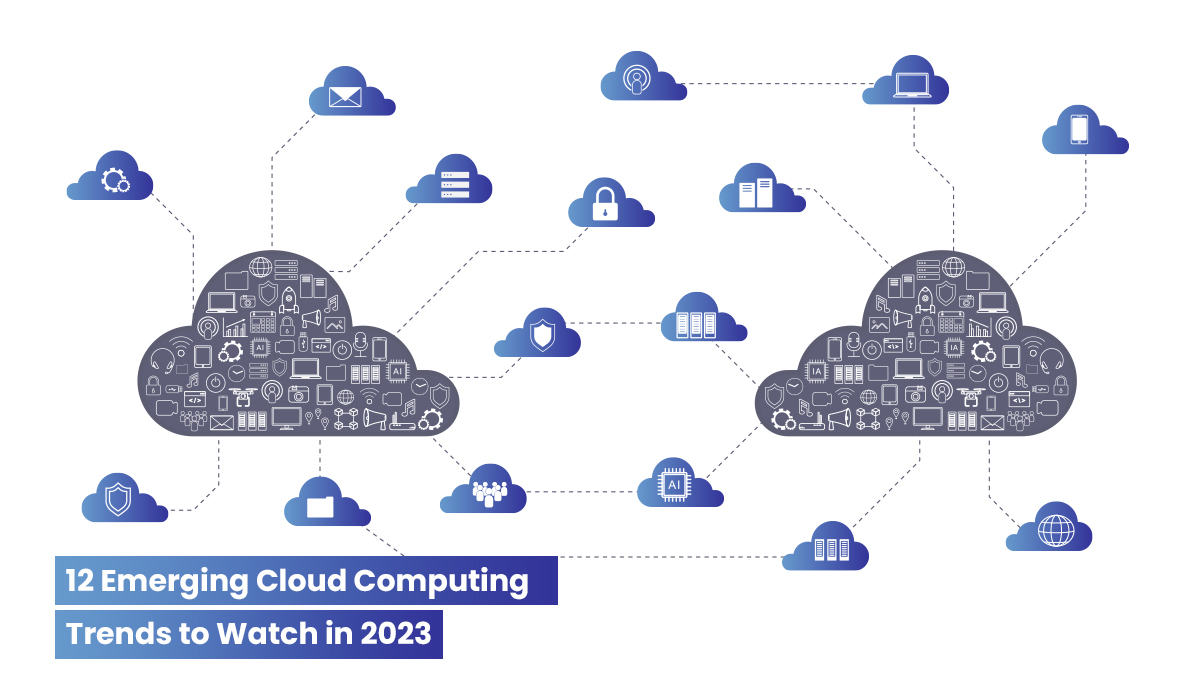12 Emerging Cloud Computing Trends in 2023: From Hybrid Cloud to Serverless Computing and Beyond

Cloud technology is always improving, so it's hard to anticipate precise trends in 2023. It gained popularity between 2020 and 2021 as businesses responded to the global pandemic by focusing on delivering digital services. It is only expected to rise further as new capabilities and deployment patterns emerge, giving organizations of all sizes and sectors more ways to consume and benefit from their cloud investments.
According to Gartner, global spending on cloud services is expected to reach $482.155 billion in 2022, up from $313.853 billion in 2020. While it is impossible to predict the future with any degree of certainty, businesses can benefit from considering some of the trends that may cause changes in their industry. This blog is all about some of the current developments in cloud computing.
12 Cloud Computing trends of 2023

The information you find in this article is essential to staying competitive in the constantly changing field of cloud computing because all of the trends listed below will have an effect well beyond the current year.
1. Multi-cloud and hybrid cloud
Organizations increasingly use several cloud providers. This lets them use other providers' strengths and avoid vendor lock-in.
2. Edge computing
With more IoT devices, data must be processed closer to where it's created. Real-time requirements, internet connectivity issues, and data protection rules exacerbate this.

3. Containerization and Kubernetes
Containers are common techniques to bundle and deploy software. The modern cloud application has essentially become one with microservices. Kubernetes is a common technique to manage and grow containerized workloads.
4. Serverless computing
Serverless computing lets you execute apps and services without managing infrastructure. It frees developers from worrying about provisioning and scaling servers.
This type of computing is popular because it reduces expenses and increases flexibility. Serverless computing has several benefits for companies, including
- There are no set costs for storage or bandwidth. As an alternative, you can rely on a service that is truly pay-as-you-go.
- Server management is not a concern for the internal team.
- The team can spend more time developing and coming up with new ideas because internal developers don't have to provision complicated server clusters.
- There is no risk of under or overprovisioning because serverless platforms scale automatically without any assistance from the internal team.
- Back-end failures are less likely as a result.
5. Cloud Security
Security and compliance will remain primary priorities as firms utilize cloud technologies. Improved security features and stronger compliance frameworks are coming.
6. Artificial Intelligence and Machine Learning adoptions
AI and ML are major tech developments, and cloud-based services are growing. AI and ML cloud services continue to evolve, making them more accessible and easier to utilize.
Delivering these services to users and providing the necessary infrastructure for programs with high computational demands will both be facilitated by cloud computing.
AI applications that use the cloud are not just advantageous to big businesses. Cloud computing will increasingly be used by low-tech and small businesses as a gateway to superior AI solutions.
Startups and businesses with smaller budgets would not be able to use advanced ML and AI functions without the cloud. Thankfully, cloud computing has made it possible for companies of all sizes and types to create AI/ML products.
7. 5G and Cloud
5G networks are predicted to increase in 2023, and analysts believe it will revolutionize the cloud landscape. 5G will reduce network latency and speed up cloud data processing.
8. Cloud-Native Applications
Many companies are switching from monolithic to cloud-native apps. These cloud-based apps use microservices and containerization. Cloud-native apps are flexible, scalable, and efficient.
9. Cloud-based Blockchain
As blockchain technology grows, cloud-based blockchain solutions will undoubtedly increase. This might incorporate dApps and BaaS.
10. Cloud Automation
Future cloud computing will rely heavily on automation. Automating provisioning, scaling, and monitoring reduces costs and improves efficiency.
11. Cloud Costing
Cost optimization will become more crucial as firms rely more on cloud services. Expect additional cloud cost management solutions.
12. Cloud Gaming
Cloud gaming lets consumers stream video games over the internet instead of downloading them.

Additionally, because the games are run on the cloud, players can access them from any device with a stable internet connection, including smartphones and tablets, and can even switch between devices without losing progress in their games.
Trends in Cloud Computing for 2023: Don't get left behind
Currently, using the cloud is a requirement. These projections are based on the current status, ongoing advances, and emerging technologies. New trends may emerge, thus, these aren't exhaustive. Companies must embrace the cloud and modernize their IT if they want to stay competitive. Keep up with the aforementioned trends in cloud computing, and begin planning cloud migrations as soon as possible to stay competitive.
Related Articles
Top 10 CRM Trends in 2025 that you should be aware of
Businesses need business management software, such as Customer Relationship Management System , to cultivate and maintain relationships with leads and current customers. But it is …
Read More →Subscribe to the Creatrix Blog
Fresh insights on higher education, straight to your inbox.
We respect your privacy.
Want to contribute?
We welcome thought leaders to share ideas and write for our blog.
Become a Guest Author →
